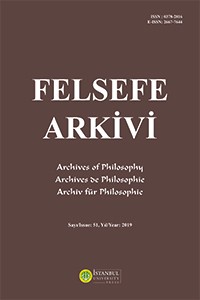Abstract
In this paper I explore whether three different approaches to connexivity – namely, Lewis and Langford’s, Wansing’s and Egré and Politzer’s – can be non-trivially related. Lewis and Langford’s approach consists of the definition of the conditional in terms of consistency via the definition of possibility in terms of consistency and Lewis’ definition of the (strict) conditional in terms of possibility; Wansing’s approach is based on his definition of the falsity condition for the conditional as “if A is true then B is false”; Egré and Politzer’s approach relies on the modalization of the falsity condition for the conditional in its conditional form (A→◇~B). With this background in mind, I build upon Estrada-González’s work relating connexivism and possibilism, the thesis according to which everything is possible. Estrada-González’s work relates Lewis and Langford’s connexive approach with Nelson’s idea that every proposition is self-consistent. He does so using a fragment of LP augmented with a special conditional. This relation has resulted in the study and postulation of several truth-functional modalities, some of which have already been discussed elsewhere. I employ several truth-functional modalities to evaluate Egré and Politzer’s falsity conditions for the conditional. I show that in using Béziau’s truth-functional modality ◇B, definable in Estrada-González’s framework, one can retain in a single framework the three different approaches. More specifically, distinguishing the notion of logical equivalence from the notion of interderivability and these two from the notion of coimplication, it is possible to relate ~(A→B) and (A→◇~B) as interderivable schemas and in a valid biconditional. I also show some consequences of this for Béziau’s negative appraisal of three-valued truthfunctional modalities.
References
- Béziau, J.-Y. “A new four-valued approach to modal logic”, Logique et Analyse 213, no. 54 (2011): 109-121.
- Egré, P. and Politzer, G. “On the negation of indicative conditionals”, In Proceedings of the Amsterdam Colloquium, edited by M. Franke, M. Aloni and F. Roelofsen, 10-18, 2013.
- Estrada-González, L. “Possibility, consistency, connexivity”, unpublished typescript, (2019). Lewis, C. I. and Langford, C. H. Symbolic Logic, New York: Dover Publications, 1932.
- Nelson, E. “Intensional relations” Mind 156, no. 39 (1930): 440-453.
- Omori, H. “Towards a bridge over two approaches in connexive logic” Logic and Logical Philosophy, no. 28 (2019): 553-566.
- Wansing, H. “Connexive modal logic” In Advances in Modal Logic, vol. 5 edited by R. Schmidt, I. PrattHartmann, M. Reynolds and H. Wansing, 367-383. London: King’s College Publications, 2005
Abstract
References
- Béziau, J.-Y. “A new four-valued approach to modal logic”, Logique et Analyse 213, no. 54 (2011): 109-121.
- Egré, P. and Politzer, G. “On the negation of indicative conditionals”, In Proceedings of the Amsterdam Colloquium, edited by M. Franke, M. Aloni and F. Roelofsen, 10-18, 2013.
- Estrada-González, L. “Possibility, consistency, connexivity”, unpublished typescript, (2019). Lewis, C. I. and Langford, C. H. Symbolic Logic, New York: Dover Publications, 1932.
- Nelson, E. “Intensional relations” Mind 156, no. 39 (1930): 440-453.
- Omori, H. “Towards a bridge over two approaches in connexive logic” Logic and Logical Philosophy, no. 28 (2019): 553-566.
- Wansing, H. “Connexive modal logic” In Advances in Modal Logic, vol. 5 edited by R. Schmidt, I. PrattHartmann, M. Reynolds and H. Wansing, 367-383. London: King’s College Publications, 2005
Details
| Primary Language | English |
|---|---|
| Subjects | Philosophy |
| Journal Section | Makaleler |
| Authors | |
| Publication Date | December 31, 2019 |
| Published in Issue | Year 2019 Issue: 51 |


